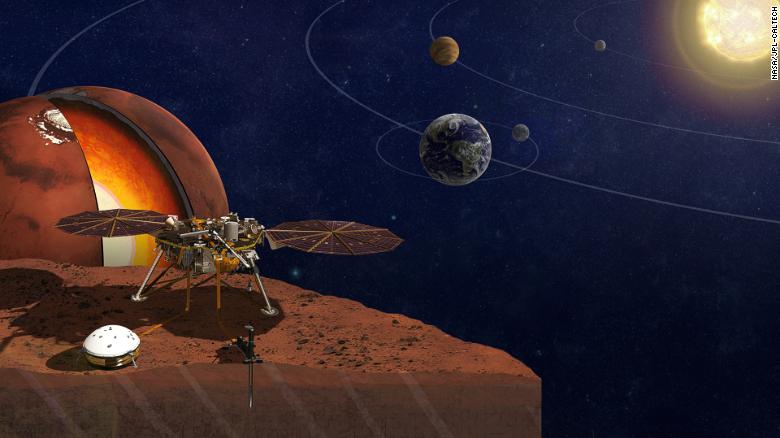NASA makes a new discovery on Mars 0:53
(CNN) -
When NASA's InSight lander touched down on Mars in 2018, the mission team hoped the stationary spacecraft would be able to conduct a survey of the interior of the red planet. Now, InSight and its instruments have surpassed those goals, revealing mysteries of the Martian crust, mantle, and core that scientists had eluded so far. It is the first time that the interior of another planet has been observed and mapped beyond the earth. The InSight mission team accomplished this extraordinary feat by tracking Martian earthquakes on the red planet, also known as "marsquakes," like the earthquakes we experience on Earth, only slightly different.
This is NASA's first full InSight selfie on Mars, taken in December 2018.
InSight's seismometer, called the Inner Structure Seismic Experiment, detected 733 different "marsquakes."
The researchers analyzed 35 of them, reaching magnitudes between 3.0 and 4.0, to determine the thickness of the Martian crust, the depth of the planet's mantle and, most importantly, a confirmation that the core of the icy planet desert is melted.
These images reveal mysteries of Mars 1:31
The findings were shared in three studies, all published Thursday in the journal Science.
Before InSight traveled to Mars, all previous robotic exploration of the red planet consisted of studying its surface.
"When we began to develop the mission concept more than a decade ago, the information from these jobs is what we expected to ultimately get," said Bruce Banerdt, principal investigator for InSight at NASA's Jet Propulsion Laboratory in Pasadena. , California, in a statement.
"This represents the culmination of all the work and concern of the last decade."
Know Mars through its seismicity
Unlike the Curiosity and Perseverance rovers, InSight is confined to where it landed, unable to scour the surface for intrigue.
However, the lander's incredibly sensitive seismometer has the ability to detect martemots hundreds and thousands of kilometers away.
You don't need mobility to study Mars.
advertising
When we experience an earthquake, it is because the Earth's tectonic plates shift, move and collide with each other.
So far, Earth is the only known planet to have these plates.
So how do earthquakes occur on Mars?
Think of the Martian crust as a single giant plate.
This crust has faults and fractures in its interior because the planet continues to shrink as it cools.
This puts the Martian crust under stresses that stretch and crack it.
When the seismic waves from the marsquakes traveled through the different materials of the Martian interior, they allowed the researchers to study the internal structure of the planet.
This helps them understand the mysterious Martian interior and apply this research to understand how other rocky planets, including our own, form.
InSight has been able to unlock some of the secrets of the Martian interior, shedding light on how all rocky planets form.
The seismograms collected by InSight are full of ripples, and these ripples can be noise caused by the wind or by the vibrations of marsquakes.
"What we are looking for is an echo," Amir Khan, lead author of the mantle study and a scientist at the ETH Zurich Institute of Geophysics and the University of Zurich Institute of Physics, said in a statement.
"The direct seismic waves from an earthquake are a bit like the sound of our voices in the mountains: they produce echoes," said Philippe Lognonné, principal investigator of the seismometer and professor at the University of Paris, in a statement.
"And it was these echoes, reflected in the core, or in the crust-tablecloth interface or even on the surface of Mars, that we looked for in the signals, thanks to their similarity to direct waves."
Wall-E?
New selfie of the Perseverance rover from Mars 0:41
Billions of years ago, Earth, Mars, and the other planets in our solar system formed from a disk of material around the sun, which included clumps of dust and rocks.
Planets are incredibly hot when they form.
Over time, different layers emerged on Mars during those first million years, including the crust, mantle, and core.
"Now seismic data has confirmed that Mars apparently was once completely molten before splitting into the crust, mantle and core that we see today, but that these are different from Earth," Khan said.
Earth has a thin crust of rock that surrounds a thick rock mantle, which surrounds a core made largely of iron and nickel.
The data collected by InSight helped the researchers learn that the thinner-than-expected Martian crust is about 12 miles deep.
This crust may contain sub-layers that extend it about 23 miles deep from the surface.
This artist's illustration shows the InSight lander, its sensors, cameras, and instruments.
"Stratification within the crust is something we see all the time on Earth," said Brigitte Knapmeyer-Endrun, lead author of the study of the crust and geophysics at the University of Cologne, in a statement.
"The ripples in a seismogram can reveal properties such as a change in porosity or a more fractured layer."
Understanding how the Martian crust formed, compared to Earth's, may help researchers understand another piece of why the planets in our solar system are so different from each other.
Beneath the crust is the mantle, which travels another 1,559.5 kilometers before reaching the liquid metal core.
The researchers were able to confirm the size of the core, which has a larger-than-expected radius of 1,830 kilometers, and determine that the core is molten.
The liquid core contains iron and nickel, as well as lighter elements such as sulfur, oxygen, carbon, and hydrogen.
"This study is a once-in-a-lifetime opportunity," Simon Stähler, lead author of the core study and a seismologist at ETH Zurich, said in a statement.
"It took scientists hundreds of years to measure the core of the Earth; after the Apollo missions, it took 40 years to measure the core of the Moon. InSight took only two years to measure the core of Mars."
Earth has a molten outer core that surrounds a solid inner core.
The InSight mission, which has been extended to 2022, will continue to search for data that can show whether Mars is similar or different from our planet in this regard.
InSight awaits the big moment
Mars was once a volcanically active planet.
Volcanic regions are visible today across the red planet, thanks to images from orbiters.
Most of the large Mars earthquakes detected by InSight come from a specific region: Cerberus Fossae.
This region, which may have been volcanically active only a few million years ago, is littered with rock tracks, probably created when they moved due to earthquakes.
The largest earthquakes detected by NASA's InSight appear to have originated in a region of Mars called Cerberus Fossae, imaged by the HiRISE camera on NASA's Mars Reconnaissance Orbiter.
Meanwhile, other volcanic regions of Mars appear to be quiet.
But InSight is still listening and waiting for Marsquakes with magnitudes greater than 4.0.
"We would still love to see a big one," said Mark Panning, a co-author of the crust study and a JPL research scientist in planetary interiors and geophysics, in a statement.
"We have to do a lot of careful processing to get what we want out of this data. Having a bigger event would make all of this easier."
The steady stream of data that InSight sends to scientists on Earth will end in about a year, when solar cells can no longer generate enough power.
But researchers will study the detections made by InSight for decades to learn as much as possible about our enigmatic planetary neighbor.
"Mars continues to pose many mysteries, among which the question of whether it was formed at the same time and from the same material as our Earth stands out," said study author Domenico Giardini, professor of seismology and geodynamics at ETH, in a statement. from Zurich.
Mars















